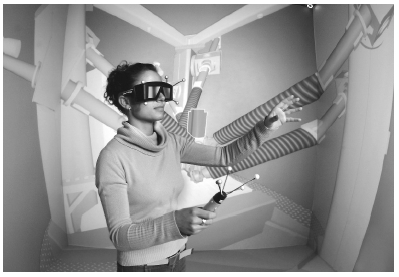Introduction
Walking onto the Holodeck
As fans of the Star Trek TV programs and movies know, crew members of the starship Enterprise like to relax by visiting the ship's Holodeck. There they can enter any landscape that their imaginations—or anyone else's—might dream up. They can relive a battle from an ancient war, stand on the swaying deck of a sailing ship tossed by a storm, or have conversations with fictional characters such as Detective Sherlock Holmes.
On the Holodeck, whatever place the crew members choose seems to be all around them. They see it, hear it, feel it, perhaps even taste and smell it. Most exciting of all, they themselves are part of the action. When they walk through a scene, their view of it changes, just as it would if they were walking in a real place. When they speak, characters in the scene answer. When they pick up a rock or a flower, they can see it move and feel its texture and weight in their hands. Yet they know that nothing in the Holodeck scenes is real. It is all created by a computer. As soon as they leave the Holodeck, its imaginary world vanishes and they are back on the starship.
An inventor named Ivan Sutherland imagined something like the Holodeck in 1965. He called it the ultimate display. He pictured it as a room

Ultimate Displays
The Holodeck and Sutherland's ultimate display have many features in common. In both, computers and related devices turn mathematical information into forms that users can perceive with their senses. People inside the displays feel completely surrounded, or immersed, in these artificial worlds. Objects in the displays look three-dimensional, with different sides of the objects appearing as viewers move around them. The displays are interactive, detecting viewers' movements and changing in response to them, and the changes occur in "real time"—as quickly as they would occur in the real world. In the late 1980s, another inventor, Jaron Lanier, gave such displays the name by which they are still best known: virtual reality , often shortened to VR. By that time, the technology needed to create them was already being developed.
Would-be starship travelers today cannot walk onto anything like the Enterprise 's Holodeck, nor can they sit in a virtual chair or dodge a virtual bullet in Sutherland's ultimate display. Nonetheless, the technology of virtual reality is starting to become part of people's lives. Players sitting in video arcades or at their home computers or game consoles use features of it to see panoramic, three-dimensional views of real or fantasy scenes. Pilots use more complex VR simulations to practice flying, and construction workers use them to learn how to operate heavy equipment. Surgeons employ virtual reality to plan operations, and psychiatrists harness it to treat some kinds of mental illness. Children in classrooms use VR to tour art and science museums, national parks, or re-created historical events. Scientists use it to see inside the earth or to manipulate molecules and atoms to make new drugs. Designers use it to create new planes, cars, and buildings.
Useful as virtual reality is beginning to be, some experts feel that it raises serious ethical questions. They say it can leave trainees and students with dangerous false impressions and even possibly damage their brains. It can cut people off from face-to-face contacts and make some become addicted to make-believe worlds. Defenders of virtual reality say that these fears are groundless or, at worst, will apply to only a handful of people.
Meanwhile, the time of the Holodeck seems to draw nearer each year as computers' speed and power increase. By the middle of the twenty-first century, many businesses and even homes may have rooms able to create convincing illusions that surround their viewers. If that day comes, virtual reality could change—for better or worse—people's feelings about what is real, what kinds of experience are important, and what it means to be a human being.
Comment about this article, ask questions, or add new information about this topic: